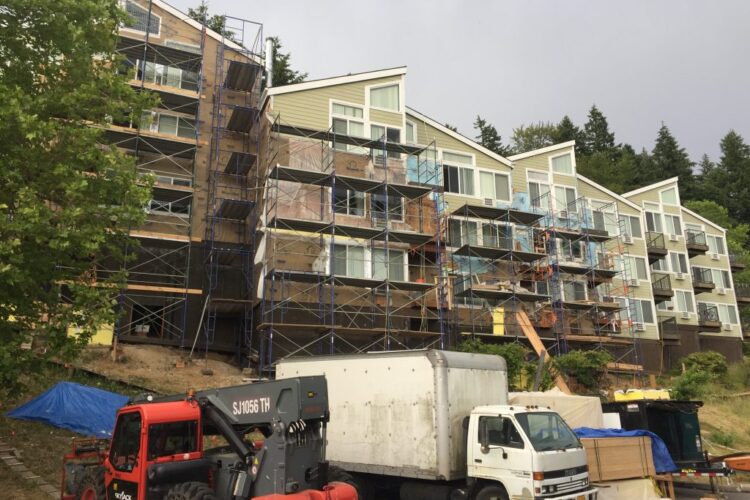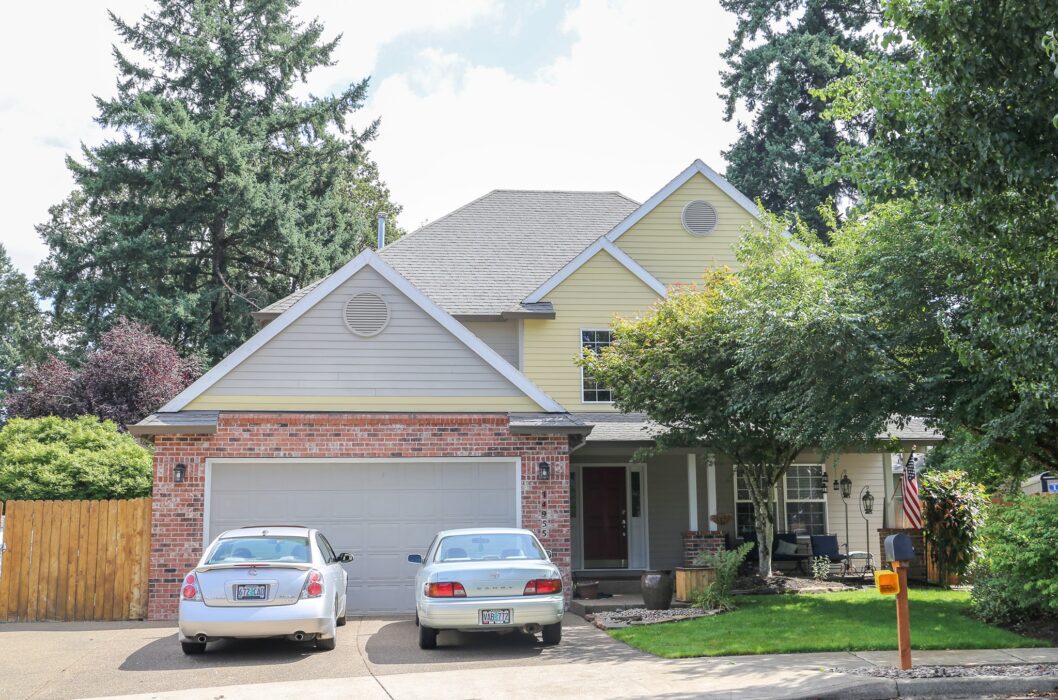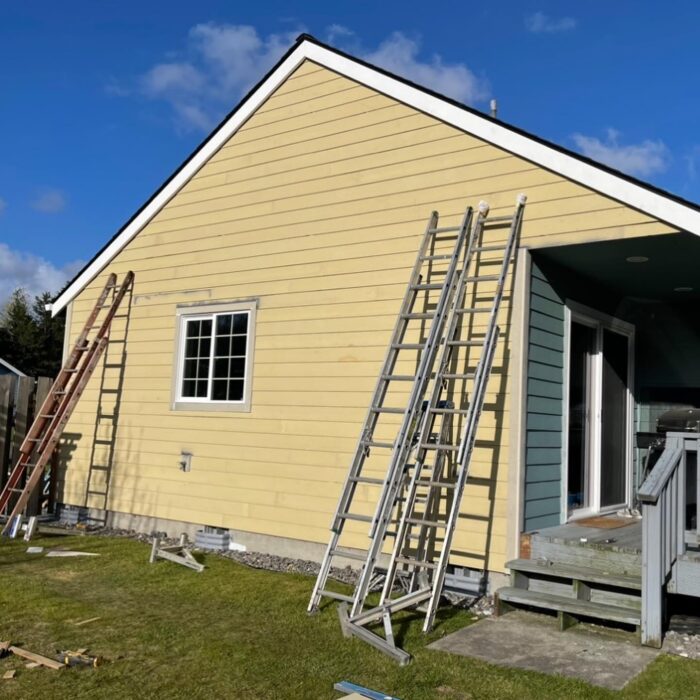
- By LADA Exteriors
- In Renovation, Repairs
Choosing The Right Siding Color For Your Home
Selecting the ideal siding color for your Portland residence is a decision marked by both excitement and the potential for being overwhelmed. The abundance of options available necessitates careful consideration of factors such as your home’s architectural style, the surrounding environment, and local design trends. This decision extends beyond mere aesthetics; the chosen siding color significantly influences your home’s curb appeal, overall visual allure, and even its property value for the foreseeable future.
To find the perfect siding color, start by observing the colors of neighboring homes and the prevalent color schemes in your vicinity. This offers inspiration and ensures that your home seamlessly integrates into its surroundings. Moreover, consider Portland’s climate and weather conditions, as they can impact certain colors and materials’ durability and maintenance needs. These things will guide you toward a siding color that enhances your home’s charm and harmonizes with the city’s unique ambiance.
Understanding Portland’s Climate and Its Influence on Siding Colors
Portland’s climate is characterized by mild, rainy winters and cool, dry summers. This distinct climate, marked by frequent precipitation and fluctuating temperatures, plays a pivotal role in the longevity of your chosen siding color. Lighter shades may be susceptible to sun-induced fading, while more intense colors could weather over time. Therefore, selecting a siding color that aligns with the climate ensures that your home maintains its aesthetic appeal through the years.
Moreover, be mindful that your siding color choice can impact your home’s resale value. A harmonious color scheme that complements the neighborhood’s overall aesthetic has the potential to enhance curb appeal, attracting prospective buyers.
How Your Home’s Architectural Style Affects Siding Color
 Identifying your home’s architectural style is crucial in the siding color selection process. Colors work differently with various designs, contributing to the overall visual appeal of your home. To determine your home’s architectural style, scrutinize its structure, roof design, window shapes, and decorative accents. For example, Craftsman-style homes in Portland, characterized by low-pitched roofs and handcrafted details, often favor earthy tones and warm colors like those found in wood or fiber cement siding.
Identifying your home’s architectural style is crucial in the siding color selection process. Colors work differently with various designs, contributing to the overall visual appeal of your home. To determine your home’s architectural style, scrutinize its structure, roof design, window shapes, and decorative accents. For example, Craftsman-style homes in Portland, characterized by low-pitched roofs and handcrafted details, often favor earthy tones and warm colors like those found in wood or fiber cement siding.
Contemporary or modern homes, with clean lines and simple palettes, may benefit from neutral shades or bold, solid colors that complement their minimalistic style. Though less common, Victorian homes with ornate trims and decorative moldings could embrace contrasting colors and bold hues to accentuate intricate design elements.
You ensure a cohesive and visually appealing exterior by aligning your siding color with your home’s architectural style.
Neighborhood Influences and Local Trends on Siding Color
Considering neighborhood influences and local trends is essential when choosing a siding color. Observe the color schemes of homes you admire in your area for valuable insights. This step ensures that your color choice contributes to the overall aesthetic harmony of the neighborhood.
Given Portland’s lush green surroundings, siding colors that complement or contrast with the natural environment are advisable. Earth tones like beige, taupe, or greige blend seamlessly with the surroundings. Darker, richer colors like navy blue can contrast sharply against the green backdrop.
Exploring current trends in siding colors is also beneficial. Modern trends often incorporate popular neutrals with bold accents, creating a balanced yet updated look. For instance, a neutral base coupled with bright accents, such as a red door or white trim, can balance traditional and contemporary styles.
Remember that your siding color choice can impact your home’s resale value, so opting for a color that appeals to a broad range of potential buyers is wise.
The Role of Exterior Lighting on Siding Color
Portland’s climate, characterized by cloudy and cool conditions, results in softer, diffused light. This unique lighting environment influences how siding colors appear, making choosing colors that maintain their appeal in such conditions crucial. Additionally, the direction your home faces plays a significant role. North-facing homes receive less sunlight, resulting in cooler shadows, while south-facing homes experience brighter, warmer colors due to increased sunlight exposure.
To accurately gauge how different siding colors will appear on your home, observe color samples in various lighting conditions. This ensures that your chosen color complements both the surrounding environment and your home’s overall aesthetic.
Color Theory and Design Principles: Choosing Complementary and Contrasting Colors
Consider color theory and design principles in siding color selection to create a harmonious and visually appealing exterior. Complementary colors, positioned opposite each other on the color wheel, offer a harmonious look. Contrasting colors, with a strong difference in hue, create visual interest and make a bold statement. Your home’s architecture, including roof and trim colors, can guide your choice to ensure a cohesive look.
The Impact of Sunlight and Shadows on Siding Colors
Given Portland’s weather, where sunlight may be limited, it’s essential to consider the impact of sunlight and shadows. Sunlight can make colors appear more vibrant, while shadows have a softening effect. Test your chosen color on a sample section of your siding to observe how it looks under varying light conditions before making a final decision.
The 60 – 30 – 10 Rule
Applying the 60-30-10 rule, which divides a color scheme into three parts—60% for the dominant color, 30% for the secondary color, and 10% for an accent color—can create a balanced and visually appealing exterior. This rule can guide your choice for the dominant siding color, secondary trim color, and accent color for elements like the front door or decorative accents.
The Importance of Siding Color Complementing the Home’s Exteriors
Choosing the right siding color involves taking your home’s surroundings into account. This includes the neighborhood aesthetics, natural environment, and landscaping. Ensuring that your home’s exterior complements its setting enhances its overall appearance.
The Influence of Natural Environment on Siding Choice
The natural environment around your Portland home significantly influences siding color choices. Coastal or waterside settings may favor blues, grays, and whites for an ocean-inspired aesthetic. In lush, wooded areas, earthy tones like greens, browns, and tans blend seamlessly into the surroundings.
The Effect of Landscaping on Siding Color
Consider your home’s landscaping when selecting a siding color. The exterior should harmonize with the greenery, hardscaping, and accent features. A vibrant garden with colorful flowers may benefit from a neutral siding color, providing a backdrop for the plants. In contrast, a modern landscape may complement bold, striking siding colors.
Visualizing and Sampling Siding Colors Before Committing
To facilitate decision-making, explore siding color visualizer tools that virtually apply colors to your home. Tools like the Siding Visualizer Tool by LP Building Solutions and the Exterior House Color Visualizer by James Hardie allow you to upload a photo of your house and experiment with various siding colors. Obtain exterior paint color samples from a local paint store for a tangible examination. Placing these color swatches against your house helps gauge their compatibility with your home’s architectural style and other exterior elements.
Don’t hesitate to test bold colors, as they can create a unique, eye-catching look. However, in a city like Portland, where earthy colors are prevalent, opting for a muted or neutral palette can provide a timeless and elegant appearance.
Seeking Expert Advice and Assistance
As seeking expert advice is crucial during roofing replacement, consulting siding professionals brings multiple benefits to selecting siding colors. Professionals can provide personalized recommendations based on your home’s architecture, style, and environmental factors. Experts can guide you toward siding colors resistant to these elements in the Pacific Northwest, where homes are exposed to rain and moisture, ensuring long-lasting results.
Expert input also expands your color options, presenting unique schemes that enhance your home’s curb appeal while blending seamlessly with the neighborhood. In conclusion, seeking expert advice ensures your home’s exterior is visually appealing and durable.
Choosing the right siding color for your Portland home involves considering both aesthetic and practical factors. Considering the city’s climate is crucial, ensuring that the selected color can withstand precipitation and retain vibrancy. The chosen siding color can also significantly impact the property’s value and curb appeal.
The process may require research and deliberation, considering the existing color palette, local climate, and potential effects on property value. Ultimately, homeowners can make a confident decision by selecting a siding color that enhances their home’s beauty and functionality, embodying a timeless and harmonious appeal.
Frequently Asked Questions
 What factors should I consider when selecting siding colors?
What factors should I consider when selecting siding colors?
When choosing siding colors, consider the architecture of your home, as certain colors work better with specific designs. For example, Victorian homes favor bold and darker colors, while Craftsman homes work well with earthy hues like olive green or beige. Also, consider your home’s surroundings and local climate; the Pacific Northwest often calls for colors that blend well with the natural environment.
How can I visualize different siding colors in my home?
Online tools like James Hardie’s Exterior House Color Visualizer enable you to experiment with different siding colors on various home styles. These tools can help find the best color match and ensure your choice complements your home’s architecture and overall aesthetic.
What are the best siding colors for homes in the Pacific Northwest?
The Pacific Northwest is known for its lush forests and coastal views, so siding colors that blend well with the natural environment are often preferred. Earthy tones like greens, browns, and grays are popular choices. Blues and grays also work well for homes located near the coast. Ultimately, the best color choice for your Portland home will depend on your personal preference and your home’s style.
How do I ensure my siding color choice is timeless?
Opt for neutral colors with enduring appeal to ensure a timeless and classic look. Light grays, beiges, and off-whites are versatile choices that adapt to changing trends and color palettes. Avoid choosing overly trendy or bold colors that might become outdated over time.
Which siding colors have the highest resale value?
Neutral colors such as whites, grays, and beiges typically offer the highest resale value, as they appeal to a broad range of buyers. These lighter shades have a classic and timeless quality that can make a home feel more welcoming and inviting. A well-chosen siding color can boost curb appeal, enhancing your home’s overall exterior presentation and potential resale value.





